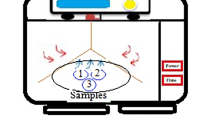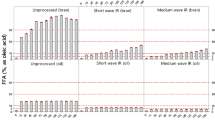Abstract
This study was aimed to investigate the inhibition of the deteriorations of rice bran by infrared radiation (IR) heating and its effects on the chemical and biological profiles during short-term storage. Freshly milled paddy rice bran was exposed to the IR until the surface temperature reached 85 °C. The results indicated that after 20 days of storage, the activities of relevant enzymes, including lipase, lipoxygenase, and peroxidase all decreased after IR-treated. The rising trend of the free fatty acid content decreased significantly during storage. IR treatment can reduce the oxidation and hydroperoxides of rice bran, which can control the rise of peroxide value till the 15 days of storage (9.7 meq/kg). The contents of palmitic acid (C16:0), oleic acid (C18:1), and linoleic acid (C18:2) were well maintained by IR heating during the whole storage period. The aroma of fresh rice bran was acceptably preserved with abundant amount of aldehydes and alkanes. After quantification of the volatile chemical compounds in rice bran, potential biomarkers specific for rice bran storage should be highlighted, being 3-octen-2-one, acetophenone, 2,4-dimethylcumene, 5,6-dimethylindane, and phytane. This study illustrates that the IR processing can effectively guarantee the stabilization of rice bran in terms of desirable FAs profiles, relevant enzymes activities, and aroma features.

Graphical Abstract


Similar content being viewed by others

Abbreviations
- CK:
-
Control check
- d.b:
-
Dry basis
- FAs:
-
Fatty acids
- FFAs:
-
Free fatty acids
- IR:
-
Infrared radiation
- LOX:
-
Lipoxygenase
- MC:
-
Moisture content
- MUFA:
-
Monounsaturated fatty acids
- POD:
-
Peroxidase
- POV:
-
Peroxide value
- PUFA:
-
Polyunsaturated fatty acids
- RB:
-
Rice bran
- RBO:
-
Rice bran oil
- SFA:
-
Saturated fatty acids
References
ASAE. (1995). Moisture relationships of grains. Moisture measurements-ungrounded grain seeds (42nd ed., Vol. S 352.2). Street Joseph, Michigan: ASAE.
Brunschwiler, C., Heine, D., Kappeler, S., Conde-Petit, B., & Nyström, L. (2013). Direct measurement of rice bran lipase activity for inactivation kinetics and storage stability prediction. Journal of Cereal Science, 58(2), 272–277.
Chua, L. Y. W., Chong, C. H., Chua, B. L., & Figiel, A. (2019). Influence of drying methods on the antibacterial, antioxidant and essential oil volatile composition of herbs: a review. Food and Bioprocess Technology, 12(3), 450–476.
Curti, C. A., Curti, R. N., Bonini, N., & Ramón, A. N. (2018). Changes in the fatty acid composition in bitter Lupinus species depend on the debittering process. Food Chemistry, 263, 151–154.
Ding, C., Khir, R., Pan, Z., Zhao, L., Tu, K., El-Mashad, H., & McHugh, T. H. (2015). Improvement in shelf life of rough and brown rice using infrared radiation heating. Food and Bioprocess Technology, 8(5), 1149–1159.
Ding, C., Khir, R., Pan, Z., Wood, D. F., Berrios, J., et al. (2018). Influence of infrared drying on storage characteristics of brown rice. Food Chemistry, 264, 149–156.
Eshghi, N., Asnaashari, M., Haddad Khodaparast, M. H., & Hosseini, F. (2014). Evaluating the potential of natural curcumin for oxidative stability of soybean oil. Natural Product Research, 28(17), 1375–1378.
Frankel, E. (1984). Lipid oxidation: mechanisms, products and biological significance. Journal of the American Oil Chemists' Society, 61(12), 1908–1917.
Irakli, M., Kleisiaris, F., Mygdalia, A., & Katsantonis, D. (2018). Stabilization of rice bran and its effect on bioactive compounds content, antioxidant activity and storage stability during infrared radiation heating. Journal of Cereal Science, 80, 135–142.
Goffman, F. D., & Bergman, C. (2003). Hydrolytic degradation of triacylglycerols and changes in fatty acid composition in rice bran during storage. Cereal Chemistry, 80(4), 459–461.
Jaisut, D., Prachayawarakorn, S., Varanyanond, W., Tungtrakul, P., & Soponronnarit, S. (2009). Accelerated aging of jasmine brown rice by high-temperature fluidization technique. Food Research International, 42(5-6), 674–681.
Kim, S. M., Chung, H. J., & Lim, S. T. (2014). Effect of various heat treatments on rancidity and some bioactive compounds of rice bran. Journal of Cereal Science, 60(1), 243–248.
Krishnamurthy, K., Khurana, H. K., Soojin, J., Irudayaraj, J., & Demirci, A. (2008). Infrared heating in food processing: an overview. Comprehensive Reviews in Food Science and Food Safety, 7(1), 2–13.
Kong, Z., Dong, F., Xu, J., Liu, X., Li, J., Li, Y., Tian, Y., Guo, L., Shan, W., & Zheng, Y. (2012). Degradation of acephate and its metabolite methamidophos in rice during processing and storage. Food Control, 23(1), 149–153.
Li, B., Zhao, L., Chen, H., Sun, D., Deng, B., Li, J., Liu, Y., & Wang, F. (2016). Inactivation of lipase and lipoxygenase of wheat germ with temperature-controlled short wave infrared radiation and its effect on storage stability and quality of wheat germ oil. PLoS One, 11(12), e0167330.
Liu, K., Li, Y., Chen, F., & Yong, F. (2016). Lipid oxidation of brown rice stored at different temperatures. International Journal of Food Science & Technology, 52(1), 188–195.
Mottram, D. S. (1998). Flavour formation in meat and meat products: a review. Food Chemistry, 62(4), 415–424.
Orthoefer, F.T. (2005). Rice bran oil. In: Shahidi, F. (Ed.), Bailey’s Industrial Oil and Fat Products (pp. 65–489). Hoboken, NY: John Wiley & Sons Inc.
Patil, S. S., Kar, A., & Mohapatra, D. (2016). Stabilization of rice bran using microwave: process optimization and storage studies. Food and Bioproducts Processing, 99, 204–211.
Peanparkdee, M., Yamauchi, R., & Iwamoto, S. (2018). Characterization of antioxidants extracted from Thai riceberry bran using ultrasonic-assisted and conventional solvent extraction methods. Food and Bioprocess Technology, 11(4), 713–722.
Pei, Y., Tao, T., Yang, G., Wang, Y., Yan, W., & Ding, C. (2018). Lethal effects and mechanism of infrared radiation on Sitophilus zeamais and Tribolium castaneum in rough rice. Food Control, 88, 149–158.
Pourali, O., Asghari, F. S., & Yoshida, H. (2009). Simultaneous rice bran oil stabilization and extraction using sub-critical water medium. Journal of Food Engineering, 95(3), 510–516.
Qian, J. Y., Gu, Y. P., Jiang, W., & Chen, W. (2014). Inactivating effect of pulsed electric field on lipase in brown rice. Innovative Food Science & Emerging Technologies, 22, 89–94.
Ramezanzadeh, F. M., Rao, R. M., Windhauser, M., Prinyawiwatkul, W., Tulley, R., & Marshall, W. E. (1999). Prevention of hydrolytic rancidity in rice bran during storage. Journal of Agricultural and Food Chemistry, 47(8), 3050–3052.
Sawai, J., Sagara, K., Hashimoto, A., Igarashi, H., & Shimizu, M. (2003). Inactivation characteristics shown by enzymes and bacteria treated with far-infrared radiative heating. International Journal of Food Science & Technology, 38(6), 661–667.
Schmidt, C. G., Gonçalves, L. M., Prietto, L., Hackbart, H. S., & Furlong, E. B. (2014). Antioxidant activity and enzyme inhibition of phenolic acids from fermented rice bran with fungus Rizhopus oryzae. Food Chemistry, 146, 371–377.
Shantha, N. C., & Decker, E. A. (1994). Rapid, sensitive, iron-based spectrophotometric methods for determination of peroxide values of food lipids. Journal of AOAC International, 77(2), 421–424.
Shen, Z., Palmer, M. V., Ting, S. S., & Fairclough, R. J. (1997). Pilot scale extraction and fractionation of rice bran oil using supercritical carbon dioxide. Journal of Agricultural and Food Chemistry, 45(12), 4540–4544.
Silventoinen, P., Rommi, K., Holopainen-Mantila, U., et al. (2019). Biochemical and techno-functional properties of protein- and fibre-rich hybrid ingredients produced by dry fractionation from rice bran. Food and Bioprocess Technology, 9(12), 1487–1499.
Wang, T., Khir, R., Pan, Z., & Yuan, Q. (2017). Simultaneous rough rice drying and rice bran stabilization using infrared radiation heating. LWT- Food Science and Technology, 78, 281–288.
Wanyo, P., Kaewseejan, N., Meeso, N., & Siriamornpun, S. (2015). Marigold flower-powder exhibits significant potential to inhibit lipid oxidation in rice bran tea. Food & function, 6(6), 1808–1817.
Xia, Q., Tao, H., Li, Y., Pan, D., Cao, J., et al. (2020). Characterizing physicochemical, nutritional and quality attributes of wholegrain Oryza sativa L. subjected to high intensity ultrasound-stimulated pre-germination. Food Control, 108, 106827.
Yalcin, S., & Basman, A. (2015). Effects of infrared treatment on urease, trypsin inhibitor and lipoxygenase activities of soybean samples. Food Chemistry, 169, 203–210.
Yılmaz, N., Tuncel, N. B., & Kocabıyık, H. (2014). Infrared stabilization of rice bran and its effects on γ-oryzanol content, tocopherols and fatty acid composition. Journal of the Science of Food and Agriculture, 94(8), 1568–1576.
Zhu, S. M., Lin, S. L., Ramaswamy, H. S., Yu, Y., & Zhang, Q. T. (2017). Enhancement of functional properties of rice bran proteins by high pressure treatment and their correlation with surface hydrophobicity. Food and Bioprocess Technology, 10(2), 317–327.
Acknowledgments
We would like to express our gratitude to Dr. Xiangfei Li for his valuable assistance on the manuscript.
Funding
The authors thank the National Natural Science Foundation of China (NSFC: 31601402) for financial support, and the National Key Research and Development Program of China (Contract No.2017YFD0401403), the Jiangsu Province (China) Agricultural Innovation Project (Contract No. CX (17)1002-05), the Priority Academic Program Development of Jiangsu Higher Education Institutions (PAPD), and the Postgraduate Research & Practice Innovation Program of Jiangsu Province (KYCX18_1409).
Author information
Authors and Affiliations
Corresponding authors
Ethics declarations
Conflict of interest
The authors declare that they have no conflict of interest.
Additional information
Publisher’s Note
Springer Nature remains neutral with regard to jurisdictional claims in published maps and institutional affiliations.
Highlights
•Infrared radiation heating can improve the storage stability of RB;
•Enzyme activity of RB significantly inhibited after infrared radiation heating;
•The composition of the essential FAs can be highly influenced by IR pretreatment;
•Fresh aroma characters for RB were well preserved after infrared treatment.
Rights and permissions
About this article
Cite this article
Yan, W., Liu, Q., Wang, Y. et al. Inhibition of Lipid and Aroma Deterioration in Rice Bran by Infrared Heating. Food Bioprocess Technol 13, 1677–1687 (2020). https://doi.org/10.1007/s11947-020-02503-z
Received:
Accepted:
Published:
Issue Date:
DOI: https://doi.org/10.1007/s11947-020-02503-z



